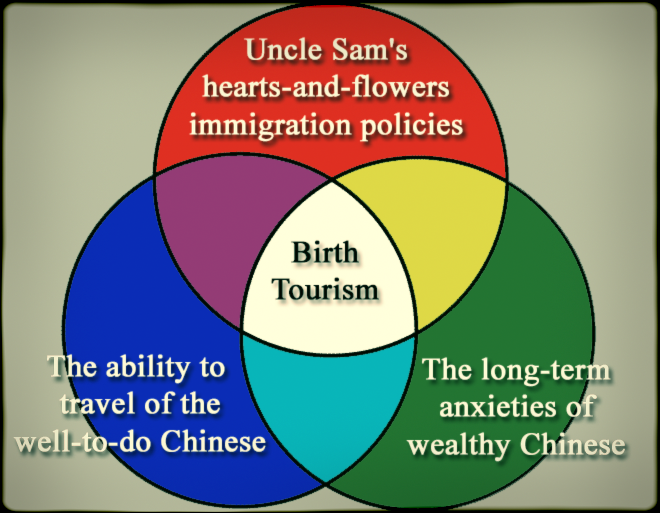Birth tourism — which recently has become a local controversy in Southern California — arises from a confluence of strong factors, illustrated in the diagram below.
Birth tourism is the planned birth of an infant in the United States by a visiting alien mother who seeks at-birth citizenship for the baby; typically she and the baby leave the country after the birth, but the child can return at any time in the future, and years later can set in motion the legal immigration of his or her parents and other family members.
The number of this kind of births is growing, but the numbers are totally dwarfed by the births in the United States to full-time resident illegal aliens. The current interpretation, now challenged by some, is that both kinds of births create full citizenship for the child.
For a thorough discussion of these issues, see the CIS Backgrounder written by my colleague Jon Feere, "Birthright Citizenship in the United States: A Global Comparison".
Birth tourism recently attracted headlines on the West Coast, but more as a local health issue than as a national immigration matter. According to an AP article, local authorities in Chino Hills, a community near L.A.:
... who went to the Chino Hills home ... said the single-family home [used for birth tourism] had been divided into 17 bedrooms and 17 bathrooms. Neighbors complained of a sewage spill from an overloaded septic tank. ... The house was shut down after the city sued the owners.
Don Knabe, a Republican member of the Board of Supervisors in nearby Los Angeles County, said of the facilities often housing birth tourism mothers, "They're a money-making machine. They're totally unsafe … they jeopardize not only the health of the baby, but the mother as well."
He advocates an L.A. County law to prohibit such operations.
The irony of the unhealthy conditions, and the overflowing sewers in Chino Hills is that the mothers are there because they are wealthy, but, as so often is the case, an earlier arriving set of people from a given nation, China in this case, is exploiting more recent arrivals from the same country.
Is self-ethno-exploitation a term? It should be. (Perhaps readers can provide a better phrase for this all-too-common, and rarely discussed, situation.)
It dawned on me as I read the AP story that three non-California factors helped explain the growth of birth tourism, as shown in the diagram below.

First, there is the deep anxiety among many of the wealthy in China about the future, and the desire among many of them to either leave China or to obtain another passport so that they, or at least their children, can leave in the future.
Second, there is the ability among the wealthy to make such a move. China does not have the same kind of exit controls that North Korea has now, and that the Soviet Union used to have; and the wealthy Chinese do have the funds to finance birth tourism, if not always the sophistication to obtain decent facilities for it.
The third force is America's hearts-and-flowers immigration policies, that not only permit the arrivals of pregnant women wanting to give birth in the United States, but facilitate immediately (upon application after the birth) the granting of a U.S. passport to the baby, no questions asked. See an earlier blog of mine for observations on a related issue, how Uncle Sam plays the Stupid Cupid when managing immigration-related marriages.
When these three factors join forces — and the three circles intersect — birth tourism for Chinese nationals is the result.
It is odd that the only action being taken about this, specifically in Chino Hills, was by the local health department.
